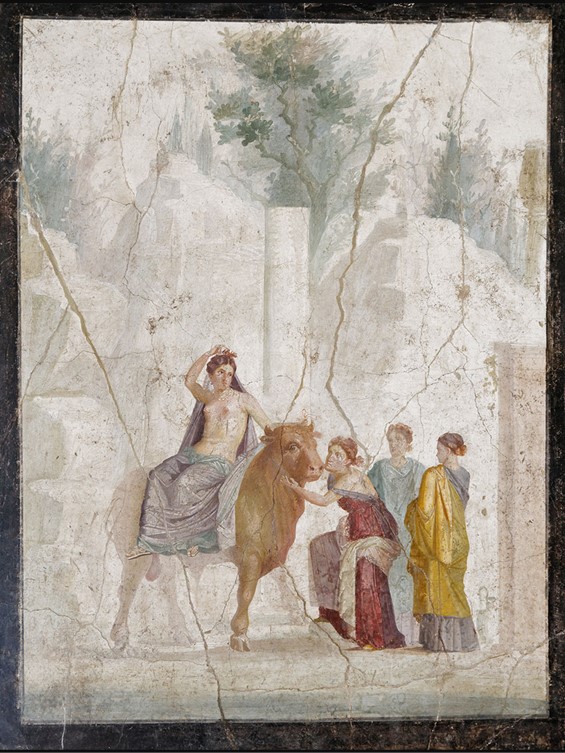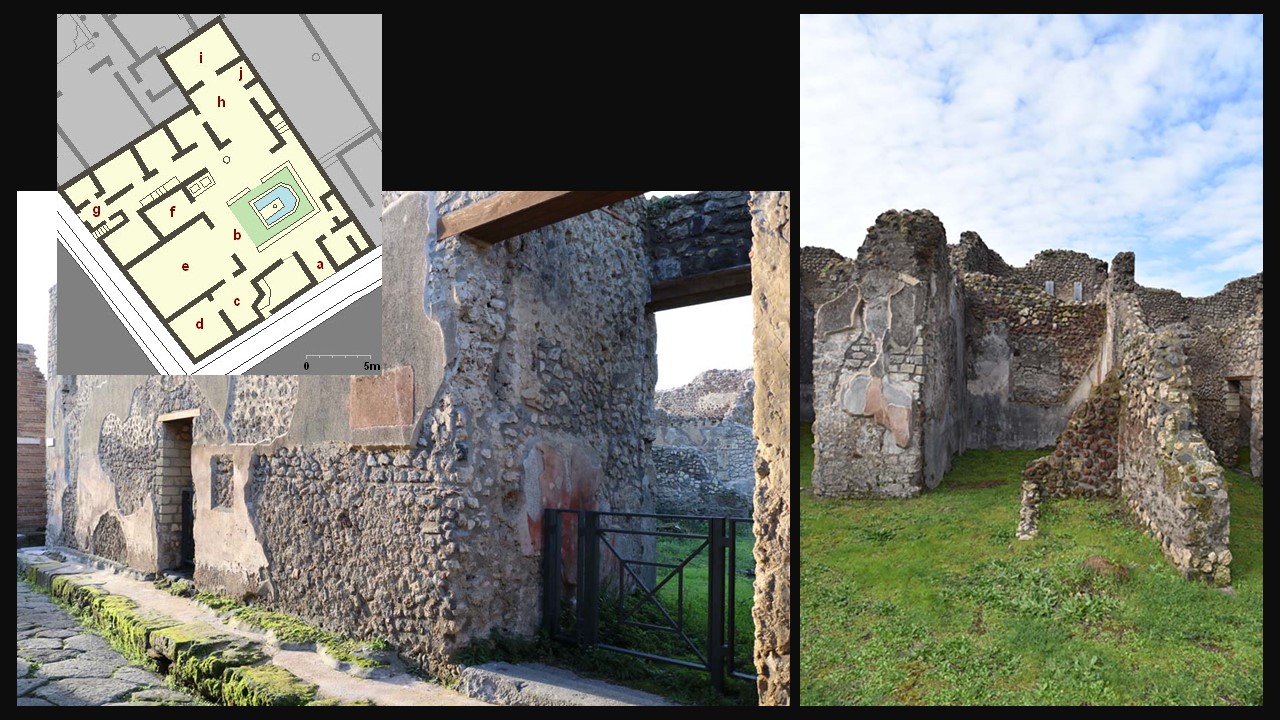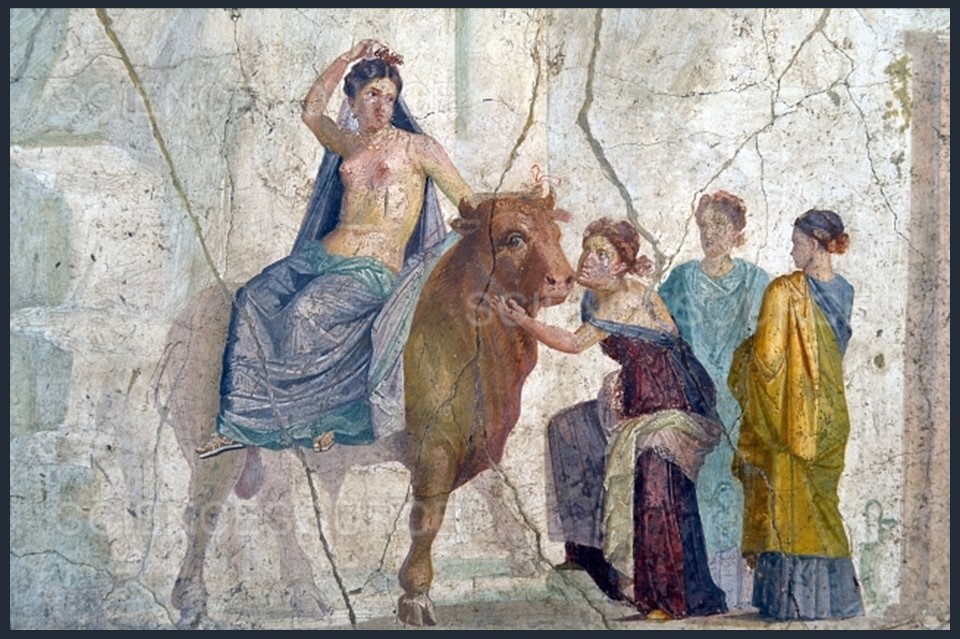
In 1878 archaeologists discovered a most wonderful fresco of the Myth of Europa on the Bull in the House of Jason in Pompeii! Let’s explore the ‘where’, ‘which’, ‘how’, and ‘what’ of this amazing fresco by posing some questions!
What is the Myth of Europa and Zeus? In the myth of the Abduction of Europa, Zeus, the king of the gods, is captivated by the beauty of Europa, a Phoenician princess and daughter of King Agenor. Seized by desire, Zeus transforms into a magnificent bull and approaches Europa with an air of gentleness. Europa, charmed by the bull’s allure, climbs onto its back, only for Zeus to swiftly take off, and carry her across the sea to the island of Crete. Upon reaching Crete, Zeus discloses his identity, and Europa becomes his queen. This myth of love and adventure, steeped in symbolism and divine intrigue, has left a lasting legacy, not only in the naming of the continent of Europe but also in its enduring influence on art, literature, and the understanding of ancient cultural values.
How does Ovis describe the Myth of the Abduction described in his Metamorphoses? So the father and ruler of the gods, who is armed with the three-forked lightning in his right hand, whose nod shakes the world, setting aside his royal sceptre, took on the shape of a bull, lowed among the other cattle, and, beautiful to look at, wandered in the tender grass. / In colour he was white as the snow that rough feet have not trampled, and the rain-filled south wind has not melted. The muscles rounded out his neck, the dewlaps hung down in front, the horns were twisted, but one might argue they were made by hand, purer and brighter than pearl. His forehead was not fearful, his eyes were not formidable, and his expression was peaceful. Agenor’s daughter marvelled at how beautiful he was and how unthreatening. But though he seemed so gentle she was afraid at first to touch him. Soon she drew close and held flowers out to his glistening mouth. The lover was joyful and while he waited for his hoped-for pleasure he kissed her hands. He could scarcely separate then from now. At one moment he frolics and runs riot in the grass, at another he lies down, white as snow on the yellow sands. When her fear has gradually lessened he offers his chest now for virgin hands to pat and now his horns to twine with fresh wreaths of flowers. The royal virgin even dares to sit on the bull’s back, not realising whom she presses on, while the god, first from dry land and then from the shoreline, gradually slips his deceitful hooves into the waves. Then he goes further out and carries his prize over the mid-surface of the sea. She is terrified and looks back at the abandoned shore she has been stolen from and her right hand grips a horn, the other his back, her clothes fluttering, winding, behind her in the breeze. This is how Ovid describes in Bk II:833-875 Zeus’s abduction of Europa. https://ovid.lib.virginia.edu/trans/Metamorph2.htm#476707521

Where did archaeologists discover the Roman fresco of Europa’s Abduction? The fresco was discovered in the House of Jason, in 1878, in Pompeii, in Region IX, Insula 5, Entrance 18. Today, the building is in a fairly sad dilapidated condition due to weather erosion. It is a relatively small residence compared to other Pompeiian Houses, but rich in exceptional frescoes which, taken to the National Archaeological Museum in Naples, are currently exhibited.
Which famous fresco panels, exhibited in the National Archaeological Museum in Naples, were discovered in the House of Jason? In Room ‘d’, one of the House’s cubicula (bedrooms), archaeologists discovered three large mythological scenes (they have long been removed to the National Museum in Naples) depicting Paris waiting for Aphrodite, Medea, and Phaedra. Two more frescoes, Phoenix and Polyxena, and Jason and Pelias were discovered in the triclinium marked as ‘e’. Finally, Room ‘f’ provides us with three more fresco panels presenting the Abduction of Europa, Pan and the Nymphs, and Hercules, Deianira, and Nessus. https://ermakvagus.com/Europe/Italy/Pompeii/jason.html
What do we know about the discovery of the Pompeiian fresco of the Abduction of Europa? The House of Jason was originally discovered in 1878 in Pompeii, Italy. On the western side of the House, in a small Room, marked ‘f’ in the Plan, archaeologists discovered three frescoes, exhibited today in the National Archaeological Museum in Naples, the Abduction of Europa being one of them.

How can the Abduction fresco be described? The Abduction fresco captures the poignant opening of the famous Myth of Europa, where the Phoenician king Agenor’s young daughter finds herself captivated by the bull’s gentle demeanor and striking beauty. Overwhelmed by the creature’s tranquil presence, her initial fear gradually dissipates, encouraging her to daringly mount its back. Positioned on the right side of the fresco are three of Europa’s companions, with one leaning forward to tenderly caress the bull’s face. The entire composition unfolds against a backdrop of breathtaking ‘Hellenistic’ scenery, characterized by intricate rock formations, architectural motifs such as the central column, and lush greenery.
For a PowerPoint of all frescoes discovered in the House of Jason and exhibited in the National Archaeological Museum in Naples, please… Check HERE!